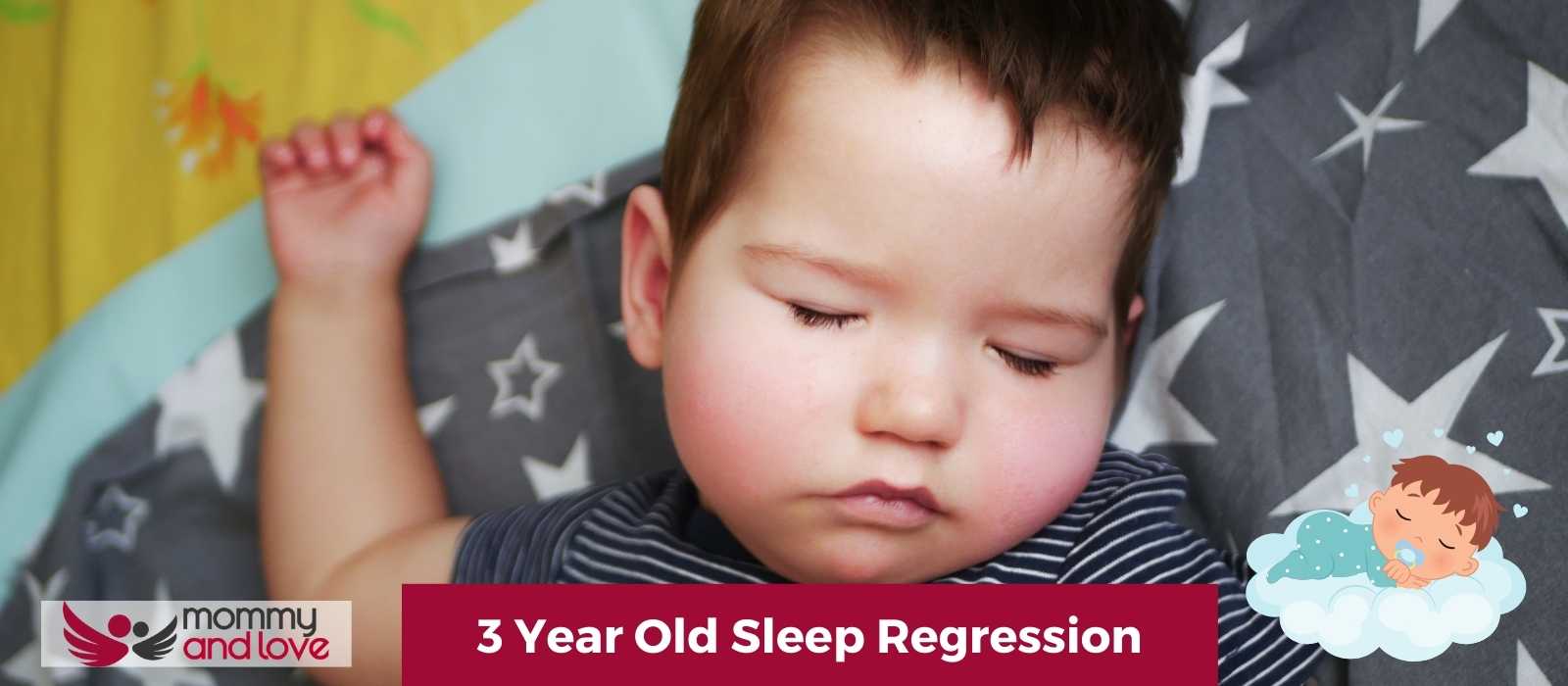Sleep regression is a normal phenomenon that toddlers experience as they are learning to become more independent. While there is no one-size-fits-all answer to the question of how long a toddler’s sleep regression will last, it is typically short-lived and resolves within a few weeks.
Around the age of 3, many toddlers experience a sleep regression where their bedtime and napping schedules become disrupted. Though not every child this age experiences it, this kind of phase is common and could sound familiar if you’ve been through similar recent sleep disturbances.
Is There a Sleep Regression at Three Years Old?
Yes, some 3-year-old toddlers experience sleep regressions which are the most common toddler sleep problems.
They are usually characterized by a toddler who has been previously an amazing sleeper suddenly developing difficulty sleeping. This can include waking up frequently during the night, having trouble sleeping, waking up early in the morning, and changes to your child’s sleep schedule.
What Causes Sleep Regression at 3 Years?
Sleep regression at 3 years is a common occurrence that can happen for a variety of reasons. By understanding these causes, parents will be better equipped to deal with the sleeping problems when it occurs.
Here are some of the common reasons why sleep issues happen at 3 years:
Developmental Milestones
When a child is learning new skills, like potty training, they can sometimes have trouble sleeping. This is because they become more independent and want to do things on their own. There are other things that might happen during this time too, like learning how to read or count. All of these things are exciting for a child and make them want to stay up later.
Separation Anxiety
Separation anxiety is common in 3-year-old toddlers. They may feel worried or anxious when they are away from their parents or primary caregivers especially during bedtime at night.
When a toddler is anxious about being away from their parents, they may have trouble settling down on their own bed for night sleep. This can lead to a lot of sleepless nights.
Separation anxiety can also cause the toddler to wake up during the night. Toddlers who are anxious about being away from their parents may wake up during the night crying or calling for their parents. This can disrupt their usual sleep pattern.
Night Terrors

Sometimes, toddlers may have night terrors. This could be due to a number of reasons, such as fear of the dark.
Fortunately, these nightly terrors will eventually go away on their own as your child grows older and becomes more comfortable with their surroundings.
Nightly terrors are one of the most common sleep problems in toddlers. They can cause your toddler to wake up screaming, sweating, and heart racing. While they can be scary for you as a parent, they are not harmful and usually only last for a few minutes.
Nap Transition
As your toddler grows, they will likely need fewer daytime naps. But the process of transitioning from two naps to one can cause some sleep problems.
The most common issue is that your toddler may start resisting their afternoon nap. They may cry or fuss when you try to put them down for a nap, or they may not fall asleep at all.
This can be frustrating for both you and your toddler. But it’s important to remember that this is a normal part of the development and usually only lasts for a few weeks.
Overtired

Being overtired can lead to your toddler suddenly fighting bedtime and staying asleep through the night. When a toddler is overtired, their body releases stress hormones that can make it hard to relax and fall asleep.
Additionally, most children who are overtired may be more likely to experience a bad dream or nightmare.
Changes in Your Toddler’s Life
Some changes and events in your toddler’s life can affect her sleep time. For instance, if your family will be welcoming a new baby within a few months, it’s best to prepare your toddler for her the arrival of her new sibling.
How Long Does the 3-Year Sleep Regression Last?
The 3-year sleep regression is a period of time where a child’s sleep patterns change and they may start waking up more during the night. This can last a few days or up to 2-6 weeks. After this time, the child’s sleep patterns should start to return to normal.
What Are the Common Signs of 3-Year-Old Sleep Regressions?
There are a few common signs and symptoms of 3-year-old sleep regressions. They include:
- Difficulty falling asleep at bedtime or nap time
- Frequent night wakings
- Increased early wake ups
- Suddenly refuses to take daytime sleep or nap
- Irritability or crankiness
How to Deal With 3-Year-Old Toddler Sleep Regression?
As your toddler grows, changes in their sleep patterns are to be expected. However, sometimes these changes can be disruptive and make it difficult for both you and your child to get a good night’s sleep.
This phase is usually characterized by a sudden change in sleeping habits, such as difficulty falling asleep, waking up frequently during the night, or early morning waking.
These changes to your toddler’s sleeping pattern can be frustrating, there are things you can do to help your child (and yourself) get through it.
Here are a few sleep tips:
1. Stick to a Bedtime Routine
One of the best ways to deal with sleep regression is to stay consistent, remain firm and stick to your child’s bedtime routine. A consistent and soothing bedtime routine will signal to your child that it’s time to wind down and prepare for sleep. It will also help your toddler develop healthy sleep habits.
The routine can include anything that can help your toddler relax such as reading a bedtime story together while snuggling her favorite stuffed animals, a warm bath time, brushing the teeth, and some rest time before finally going to bed.
2. Help Your Toddler Fall Asleep to Minimize Night Waking
If your child is having trouble sleeping, you can help by keeping the lights low and providing soothing bedtime rituals, such as reading a book or singing a lullaby. This can also include avoiding over-stimulation by keeping noisy devices and limiting screen time a few hours before bedtime.
If your toddler sleeps in her own room and feels anxious about you leaving, keep the door ajar to tell her she’s safe. You can also turn the night light on or use an intercom or baby monitor.
3. Put Your Toddler on a Regular Sleep Schedule
If your child is used to napping during the day, try to keep their nap schedule as regular as possible. This will help ensure that they’re not overtired at bedtime, will make it easier for them to fall asleep and you will see fewer bedtime battles.
However, you should also make some adjustments to your child’s schedule and wake time when necessary depending on her sleep needs. For instance, if you can see that your toddler is showing signs that she’s ready to go to bed, give her an early bedtime.
4. Create a Safe Sleep Environment
Make your child’s room dark, quiet, and cool – all things that will help promote better sleep. Additionally, consider using a white noise machine to help drown out any outside noise that might be keeping your child awake.
5. Use a Port-A-Potty
If your child is still in potty training, make sure there is a small potty next to the toddler bed in your child’s room. It will make it easier for them to get up if they have to pee in the middle of the night.
6. Avoid Drinks Before Going to Bed
It’s best to avoid giving your child any drinks (other than water) in the hours leading up to bedtime. This will help prevent them from waking up during the night to use the restroom.
7. Try Sleep Training if You Haven’t Already
If your toddler depends on you to stay with him while she falls asleep, it’s probably about time to sleep train her. There are many sleep training methods you can implement but all of them have one clear end goal – to teach young children how to fall asleep independently. Additionally, children who undergo sleep training are more likely to develop good sleep habits which can carry on as they grow older.
8. Use a Bedtime Pass
Consider making a bedtime pass. The pass might be anything from an old credit card to a handmade coupon. Tell your toddlers that if they need something after night, they can come out one time with the pass.
Conclusion on 3-Year-Old Sleep Regression
If you are experiencing the three-year-old toddler sleep regression, know that you are not alone. It is a common occurrence and usually temporary. Most importantly, there is nothing for parents to worry about during this time – your child is just going through a developmental stage. And with our parenting tips, dealing with sleep regression will be a breeze.
FAQs on 3-Year-Old Sleep Regression
How Much Sleep Does Your 3-Year-Old Need?
Most 3-year-olds need between 11 and 12 hours of sleep every day. This includes naps during the day. Some 3-year-olds may only need 10 hours of sleep, while others may need up to 13 hours. If your child is not getting enough sleep, it can affect their mood, behavior, and ability to learn.
Is It Normal for a 3-Year-Old to Stop Napping?
Yes, it’s normal for 3-year-olds to experience nap transitions by taking fewer naps than usual during the day. Some toddlers even drop naps altogether. This is because as children get older, they need less sleep. So don’t worry if your child starts skipping naps occasionally – it’s just a sign that they’re growing up.

This article was written by: Gian MIller – Full-Time Writer, Baby Whisperer & Dad of 3.
Gian spends a lot of his time writing. A self-proclaimed baby whisperer, Gian has been through it all with his own children and is passionate about sharing his hard-won wisdom with other parents. When he’s not writing or changing diapers, you can find him playing the guitar or watching baseball (or preferably both at the same time).




